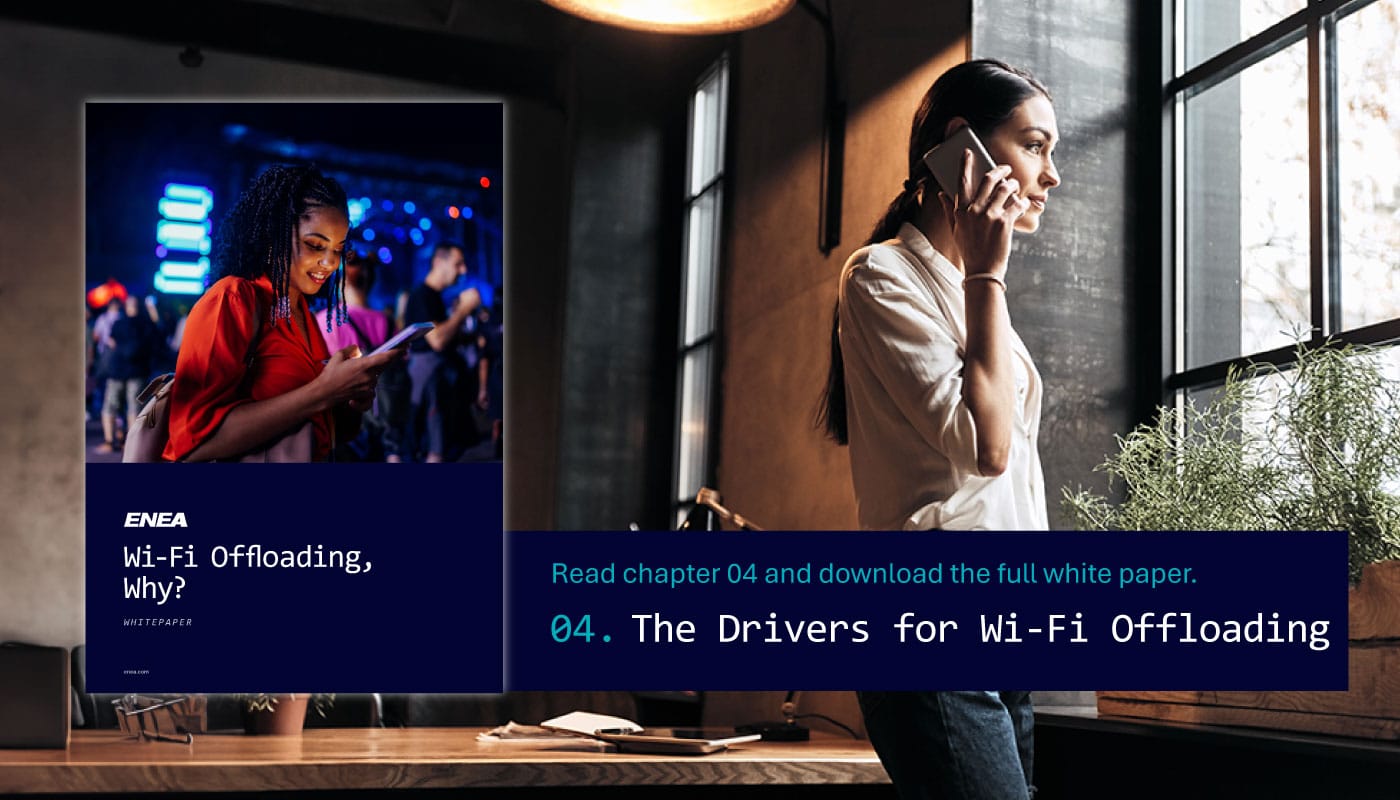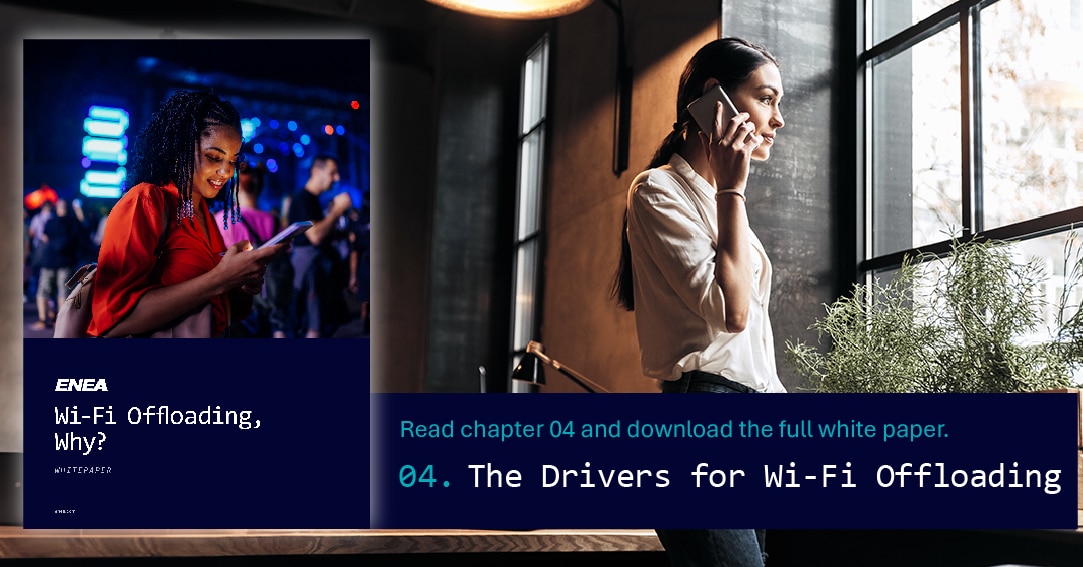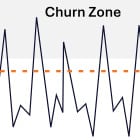
White Paper: Wi-Fi Offloading – Why?
This is an excerpt from our white paper, Wi-Fi Offloading – Why? The full white paper is available here if you like what you read. Don’t hesitate to contact us if you have any questions.

Why this sudden surge in interest?
Several trends jointly drive this development in the operator community. Here, we will review some of the most important ones.
Wi-Fi has Become More Carrier-Class and Provides Additional Spectrum
As discussed in our post about Wi-Fi myths (myth #2), Wi-Fi 6 brings deterministic performance to Wi-Fi for the first time.
The Wi-Fi 6/6E and 7 technology is superior, especially in dense areas with many devices. This is another reason why this latest generation of Wi-Fi (Wi-Fi 6/6E and 7) is perfect for service providers. It keeps the latency down and the speed up when the number of users increases.
Moreover, Wi-Fi 6E, which is Wi-Fi 6 for the 6 GHz band, does almost triple the available spectrum for Wi-Fi (depending on national spectrum regulations).
Wi-Fi 7 is around the corner. It offers latency below 5 ms and theoretical speeds above 30 Gbps, making it a viable complement or alternative to private 5G. It runs on 2.4, 5, and 6 GHz bands, and for the first time, traffic can be run on both the 5 GHz and 6 GHz bands on the same mobile device for optimal performance (pending device support).
So, the argument that Wi-Fi is not carrier-grade and only best effort does not hold anymore. The realization that Cellular and Wi-Fi isn’t a matter of one or the other, but both, has finally caught up with the most pragmatic and forward-thinking mobile operators. They will need all the bandwidth and spectrum available to meet future challenges.
The Energy Crisis and 5G Make Indoor Coverage Even Harder
Reaching indoor users with a good-quality signal using outdoor macro-cell base stations has always been challenging. Already, with the lower frequencies used by 4G, 20% of buildings in the United States are struggling with proper indoor coverage. According to crowd-sourced data, 33% of the UK and Northern Ireland buildings have no cellular connectivity for 50% of the spaces. In colder climates, three-pane windows make indoor penetration even harder. Along with energy costs and environmental concerns, buildings are rapidly being upgraded with triple-glazed windows and more insulation in geographical areas previously not considered.

With 5G running on higher frequencies, indoor penetration will become more demanding than 4G. Building penetration is 100 times worse on 95% of the 5G frequency bands. So, two trends work together to make indoor cellular coverage a nightmare: the higher frequencies in 5G and the energy cost concerns.
As a result, 5G should trigger a need for a massive investment in the densification of base stations and indoor 5G deployments. The challenge for mobile operators is that 5G is, to a large extent, still a solution looking for a problem. Most users are more than happy with the speeds that 4G brings and may not be prepared to pay extra for 5G unless there is a clear value-add. The new enterprise use cases for 5G with network slicing and IoT, etc, are still in their infancy and may never happen to the extent predicted.
To keep their margins, mobile operators must find more cost-effective solutions to bring high-capacity indoor coverage for their subscribers, and this is where Wi-Fi Offloading comes in.
The good news is that many CSPs have a fixed operation/service arm deploying B2B Wi-Fi. It is just a matter of breaking organizational silos to make the most of these assets. Having one team mounting an indoor cellular solution and another deploying B2B Wi-Fi at the same venue is not the most cost-effective approach in most locations. In addition, it will not support the operator’s sustainability agenda.
MVNOs are Building Their Own 5G Core
A Mobile Virtual Network Operator (MVNO) is a cellular operator that provides services by buying network capacity from one or multiple Mobile Network Operators (MNOs).
The value an MVNO brings can range from simply reselling the MNO’s service under their name to being a full or “thick” MVNO managing everything but the radio access network. In contrast, a “light“ or “thin” MVNO does not run its own mobile core and is only differentiated from the reseller MVNO by adding SIM management.
With the cloud-native 5G architecture, it has become easier for an MVNO to step up in the value chain and take over more functions from their MNO partner(s).
More cost-effectively than ever, they can become a full (thick) MVNO operating their own mobile core. Some MVNOs in the United States have even moved one step further, becoming Hybrid MVNOs by deploying parts of the radio networks themselves in the unlicensed CBRS band.
By building their own 5G core, MVNOs will get more control over the quality of service they provide to their customers. They can also offer new services and features tailored to their specific customer needs, which is essential in the highly competitive 5G market.
Many MVNOs, such as cable operators or MSOs, already have a vast Wi-Fi network utilized for mobile data offloading. This significantly reduces the cost per GB delivered to customers. Consequently, these MVNOs are highly competitive in the market, even towards the mobile network operator (MNO) they partner with.
So, the telecoms industry is in a state of flux. Cable and Mobile Operators in the US are eating each other’s lunch. According to the financial analysts at New Street Research, both companies offer each other’s core products at the same price. Mobile operators are growing rapidly in Fixed Wireless Access (FWA) broadband based on 5G backhaul, and Cable operators are gaining market share in cellular subscriptions as MVNOs.
Finally, all the technology stars are now perfectly aligned for convergence. We have already discussed the new Wi-Fi 6 and upcoming Wi-Fi 7 technologies. But so much more has happened in our industry. In fact, more has happened only in the last few years than in the previous decade.
As discussed in our Wi-Fi myths post (Myth #3), devices have also become smarter when assessing whether to move from the cellular network to Wi-Fi and vice versa.
Passpoint (previously known as Hotspot 2.0) has been around since 2012. Now, with WBA OpenRoaming, Passpoint is starting to happen for real. OpenRoaming already has a global network of 3 million+ Wi-Fi access points (April 2024) and counting, making it easier for mobile operators to integrate a third-party Wi-Fi footprint.
We will mention the new 3GPP standard Access Traffic Steering, Switching, and Splitting (ATSSS) here for completeness, but it is not a prerequisite for Wi-Fi Offloading, nor will it happen anytime soon. As we covered in our Enea Insights post ATSSS – the Future of Wi-Fi and Cellular Convergence, the ATSSS function in the 3GPP standards may become the ‘holy grail’ of mobile data offloading. ATSSS will give mobile operators more granular control. Still, its complexity means it will likely take many years to market. However, fulfilling this standard depends on the adaptation by the mobile device vendor eco-system. Similar 3GPP initiatives, such as ANDSF, never materialized due to the lack of device support.
Industry update Tuesday, July 23, 2024
Solutions for mobile / Wi-Fi convergence
As the mobile industry enters a new and much less profitable era, Wi-Fi is growing in importance as an effective, cost-efficient, and necessary complementary solution.
Join this online Wi-Fi Now special event with Cisco, American Bandwidth, and Enea, where we explore all the current convergence offerings and their status.
When: Online Tuesday, July 23 @ 7:00 pm CEST / 10:00 am PDT
Duration: Approximately 1.5 hours including presentations, panel Q&A, and audience Q&A.






